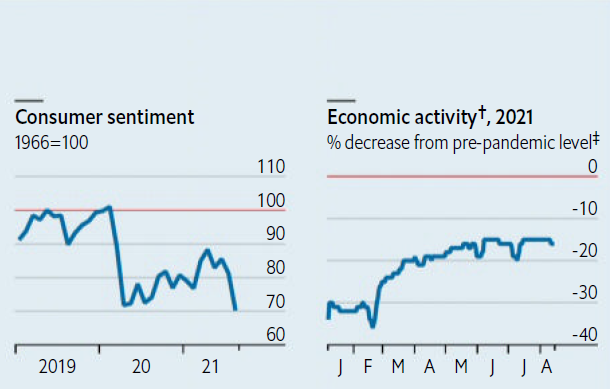That, in turn, has placed pressure on governments to extend or even increase spending on relief programmes.
這反過來又給政府帶來了壓力,迫使它們擴大甚至增加救援計劃的支出。
Economic growth is boosting tax revenues in many countries, improving the public finances that were battered by covid-19.
經濟增長提高了許多國家的稅收收入,改善了受新冠肺炎打擊的公共財政狀況。
Still, fiscal deficits remain large.
不過,財政赤字依然龐大。
A decision in June to expand grain handouts means that India’s central government is likely to borrow more than 6.8% of GDP expected in the budget for the 2022 fiscal year.
今年6月,印度政府決定擴大糧食發放,這意味著印度中央政府的舉債規模可能會超過2022財年預算中預計占GDP 6.8%的水平。
Brazil, which borrowed an eye-watering 13.4% of GDP last year, has extended its emergency cash transfers.
巴西去年借了占GDP 13.4%的巨額貸款,今年也已經擴大了緊急現金轉移支付。
Chile and Colombia, which limited their borrowing to a modest 7% of GDP in 2020 last year, are planning to borrow about as much or more this year, according to the Institute of International Finance, a bankers’ group.
根據國際金融協會(一個銀行家組織)的數據,智利和哥倫比亞去年將其借款限制在GDP的7%以內,今年計劃借款的數額與此不相上下,甚至更多。

When you combine more money flowing through the economy with supply disruptions, though, the result is inflationary pressure.
然而,當更多的貨幣流動遇上供應中斷,結果就是通脹壓力。
Emerging-market central bankers, like their rich-world counterparts, argue that high inflation is merely temporary.
新興市場的央行行長和發達國家的央行行長一樣,認為高通脹只是暫時的。
But, unlike their advanced-economy peers, some have not felt comfortable enough to wait and see.
但是,與發達經濟體的同行們不同,一些人無法悠閑地拭目以待。
They have more recent experience of bouts of high inflation, and doubt that public expectations of low inflation are as firmly anchored as in rich countries.
他們最近經歷了幾次高通脹,并且懷疑公眾對低通脹的預期是否像發達國家那樣穩固。
They have thus moved forcefully to rein in inflation.
因此,他們采取了強有力的措施來遏制通貨膨脹。
Brazil’s central bank raised interest rates by a full percentage point on August 4th, on top of three increases of 0.75 percentage points each since March.
8月4日,巴西央行將利率提高了整整一個百分點,此前,巴西央行自3月份以來已三次上調利率,每次上調0.75個百分點。
The Central Bank of Russia also announced a full-point rise on July 23rd, also its fourth of the year.
俄羅斯中央銀行也在7月23日宣布利率增加1個百分點,這也是今年的第4次加息。
Mexico and Peru raised interest rates on August 12th.
墨西哥和秘魯在8月12日提高了利率。
Other central banks that have held fire are expected to tighten in coming months.
其他未采取行動的央行預計將在未來幾個月收緊貨幣政策。
This determination to curb inflation may have kept foreign investors interested.
抑制通貨膨脹的決心可能會讓外國投資者保持興趣。
Early this year some economists worried that a roaring recovery in America and the prospect of higher interest rates there could lead to a rush of money out of emerging economies:
今年早些時候,一些經濟學家擔心,美國經濟的快速復蘇和加息的前景可能會導致資金從新興經濟體紛紛流出:
an echo of the “taper tantrum” of 2013, when the Federal Reserve began normalising monetary policy after the financial crisis.
就像2013年“縮減恐慌”的復現,當時美國聯邦儲備理事會(美聯儲,FED)在金融危機后開始正常化貨幣政策。
譯文由可可原創,僅供學習交流使用,未經許可請勿轉載。











